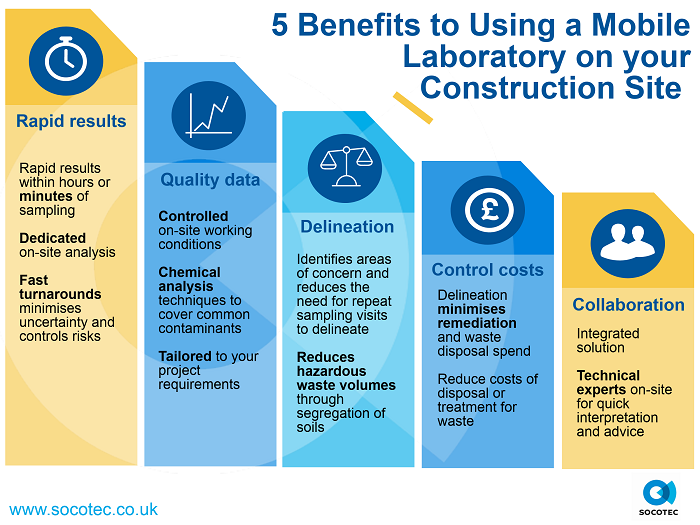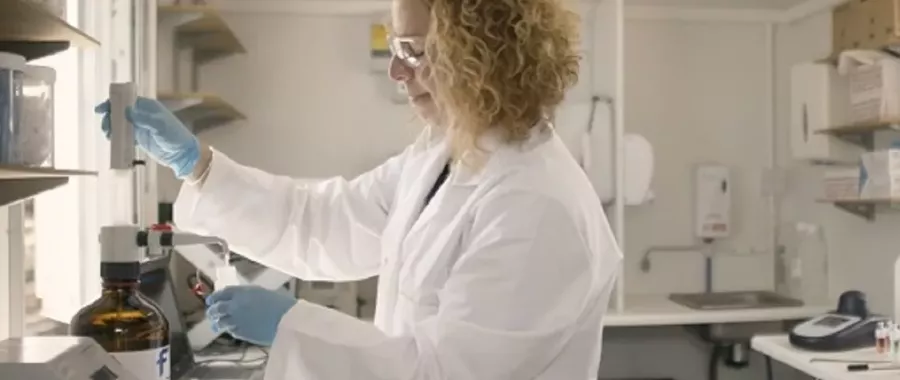
On-Site Chemical Analysis FAQs
On-site chemical analysis has the ability to rapidly provide clients with information on the nature of contamination within soils and waters.
On-site chemical analysis FAQs
Quite simply put, on-site analysis has the potential to save an organisation both time and money by avoiding worst case assumptions in decision making. With a short turnaround time for on-site analysis, clients can be better informed and therefore take less risks in their decision making process. Likewise, without long waits for data, there is a reduced cost while waiting for the outcome of pending off site laboratory results.
In addition to rapid results, the presence of a dedicated on-site laboratory service allows a much greater density of data to be obtained. This is particularly important for the delineation and characterisation of contamination on sites and a higher resolution of data can lead to the ability to vastly reduce the area of a site or volume of soil that is deemed to be contaminated and therefore requiring more expensive remedial work.
While on-site analysis is typically an additional cost to off-site analysis, there may be some offset costs due to reduced off site analysis quantities. For many projects, the volume of data available – and the speed at which it is available – is a clear benefit.
On-site analysis can lead to significant cost savings for a project for the following reasons:
Reduced volumes of hazardous waste by finer segregation
Reduced volumes of un-usable materials by finer segregation
Maximised materials direct re-use volumes
Reduced remobilisation of site investigations due to reactive sample planning allowing delineation of hotspots in one phase of works
Reduced risk of verification failures and repeat / abortive earthworks
Reduced waiting times for vital project decision making information
By reducing disposal volumes (through maximising reuse) and reducing the amount of waste classified as hazardous, organisations can reduce disposal costs.
On-site analysis laboratories can vary significantly in their size and scope. It is possible to mobilise a full range of metals, inorganic and organic analysis capability for soil, water and landfill leachate samples to site. SOCOTEC’s on-site analytical service can analyse soil and water samples for most of the contaminants that are of concern on the majority of brownfield sites although the most common metals analysis technique does not allow metals analysis in water samples.
It should be noted that on-site analysis for asbestos in soil is not readily mobilised to short term sites due to the legal restrictions and tight accreditation requirements around this analysis.
For reasons of speed, cost and sample capacity, it is normal to mobilise analytical capability for either a core suite of soil analysis to cover metals and hydrocarbon contamination or a bespoke extended suite as required (for example adding cyanide or phenol to the suite).
The very nature of contaminated land means that there are multiple factors affecting the variability and repeatability of sampling and analysis work. Even when samples are taken from the same area of the same site, variability in results can occur. This can be due to the variability on the site itself and within samples as opposed to the analysis.
That said it is clearly very important that all analysis, including on-site analysis, is carried out under controlled and repeatable conditions and to strict quality control standards. It is also important that the reporting basis is ‘like for like’ between on and off-site analysis results; this normally means dry weight reporting of results. SOCOTEC applies rigorous method validation, calibration and quality control procedures into its mobile laboratory methods and this includes in batch standards and blanks.
Furthermore, the Environment Agency (EA) has a framework for on-site testing which recommends that a ‘Demonstration of Method Applicability’ (DMA) exercise is carried out at the start of the project. The DMA provides a correlation between the on and off-site analysis by testing typically around 20 to 30 samples in both an on-site and off-site laboratory. This demonstrates that the correlation is acceptable and also indicates any bias between the two laboratories, allowing a correction factor to be applied to the on-site results as necessary. The DMA also guides the practical application of the on-site analysis in terms of setting a protocol for assessing on-site data with sufficient statistical certainty of the outcome.
It is possible to establish a laboratory with ‘full blown’ laboratory equipment and infrastructure but this is typically only desirable or cost effective on very large and long term projects. For example, SOCOTEC (formerly ESG) has previously established such a laboratory on the site of the London 2012 Olympic Games to support the site preparation and remediation works.
For the best results in terms of speed, cost and robustness, the equipment that is generally used on site allows a more simplified sample preparation process and a more rapid analysis than fixed laboratories. The EA describe these techniques as ‘Rapid Measurement Techniques’ (RMTs) - this allows the required data to be available on site reliably and quickly, while also giving a high volume of data for greater certainty.
While on-site analysis provides very rapid and reliable information, it should not be seen as a complete replacement for ‘fixed’ laboratory analysis. On-site analysis is a complementary source of information and should always be backed up by some off-site analysis ideally in the set up stages, on an ongoing basis and for ultimate verification.
Yes, the EA’s framework document published in 2009 set out the approach for the application of RMTs.
The EA recommend the application of RMTs as part of the overall risk management process for sites with potential contaminated land. SOCOTEC applies the concepts of this framework in its on-site analysis service.
You, as the client, will not need to set up the laboratory.
There are four options to consider for on-site analysis:
Establishment of a full blown site laboratory (rarely the best option)
A self-contained towable laboratory unit will be brought to site, where laboratory technicians can conduct the on-site analysis. It is beneficial to have mains power and foul drainage on site but by no means essential
Transportable laboratory equipment can be set up within temporary site accommodation – for example, a cabin that is not currently being used for any other reason on site
Transportable laboratory equipment can, in some instances, be used without having any site-based accommodation
Some applications of on-site analysis do not involve setting up a temporary site facility. For example, some equipment - such as XRF for metals – can be configured to be used hand-held in the field and there is sometimes a place for such basic testing as part of an overall risk management framework. However, it is preferable (or essential for many methods) to have more controlled conditions entailing a site laboratory set up of some description.

Why Should You Use a Mobile Laboratory?
Infographic

Want to find out more about the advantages of using a mobile laboratory? Take a look at this infographic
Want to find out more about the advantages of using a mobile laboratory? Take a look at this infographic


